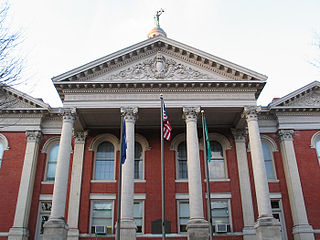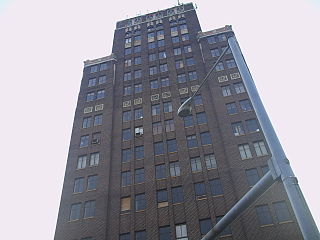
Waynesboro is an independent city in the Commonwealth of Virginia. As of the 2010 census, the population was 21,006.

Augusta County is a county in the Shenandoah Valley on the western edge of the Commonwealth of Virginia. The second-largest county of Virginia by total area, it completely surrounds the independent cities of Staunton and Waynesboro. Its county seat is Staunton, but most of the administrative services have offices in neighboring Verona.

Craigsville is a town in Augusta County, Virginia, United States. The population was 923 at the 2010 census. It is part of the Staunton–Waynesboro Micropolitan Statistical Area.

Gordonsville is a town in Orange County in the Commonwealth of Virginia in the United States. Located about 19 miles northeast of Charlottesville and 65 miles northwest of Richmond, the population was 1,496 at the 2010 census.

The Battle of Piedmont was fought June 5, 1864, in the village of Piedmont, Augusta County, Virginia. Union Maj. Gen. David Hunter engaged Confederates under Brig. Gen. William E. "Grumble" Jones north of Piedmont. After severe fighting, Jones was killed and the Confederates were routed. Hunter occupied Staunton on June 6 and soon began to advance on Lynchburg, destroying military stores and public property in his wake.

Staunton is an independent city in the U.S. Commonwealth of Virginia. As of the 2020 census, the population was 25,750. In Virginia, independent cities are separate jurisdictions from the counties that surround them, so the government offices of Augusta County are in Verona, which is contiguous to Staunton. Staunton is a principal city of the Staunton-Waynesboro Metropolitan Statistical Area, which had a 2010 population of 118,502. Staunton is known for being the birthplace of Woodrow Wilson, the 28th U.S. president, and as the home of Mary Baldwin University, historically a women's college. The city is also home to Stuart Hall, a private co-ed preparatory school, as well as the Virginia School for the Deaf and Blind. It was the first city in the United States with a fully defined city manager system.

John Daniel Imboden, American lawyer, Virginia state legislator, and a Confederate army general. During the American Civil War, he commanded an irregular cavalry force. After the war, he resumed practicing law, became a writer, and was active in land development founding the town of Damascus, Virginia.
Jefferson Hall – more formally known as "Hotel C" – is a building on the West Range of the University of Virginia. It is the traditional home of the Jefferson Literary and Debating Society; the term "Jefferson Hall" is sometimes used as a synonym for the organization.

St. Louis Union Station is a National Historic Landmark train station in St. Louis, Missouri. At its 1894 opening, the station was the largest in the world that had tracks and passenger service areas all on one level. Traffic peaked at 100,000 people a day the 1940s. The last Amtrak passenger train left the station in 1978.

The Indianapolis Union Station is an intercity train station in the Wholesale District of Indianapolis, Indiana. The terminal is served by Amtrak's Cardinal line, passing through Indianapolis three times weekly.

Staunton is an Amtrak train station in Staunton, Virginia, located in the downtown Wharf Area Historic District of the city. It is served by Amtrak's Cardinal, which runs between New York and Chicago.

The Battle of Staunton River Bridge was an engagement on June 25, 1864, between Union and Confederate forces during Wilson-Kautz Raid of the American Civil War. The battle took place around the Staunton River Bridge, over the Staunton River, in Halifax and Charlotte counties, Virginia.
Mary Julia Baldwin was a Virginia educator in Staunton, Virginia. For thirty four years she ran Mary Baldwin College, which was named in her honor in 1895 and later became Mary Baldwin University.

The Virginia Hotel was built in 1847 in Staunton, Virginia, and quickly became known as one of the finest hostelries in the commonwealth. Built on the site of the old Washington Tavern, the northeast corner of Greenville Avenue at New Street, the Virginia Hotel gained fame during the American Civil War as the headquarters of Stonewall Jackson, and served, alternately, as a hospital for Confederate soldiers and as headquarters for conquering Union Gen. David Hunter. It also served as a meeting point for several U.S. Presidents.

Augusta, Georgia was founded in 1736 as part of the British colony of Georgia, under the supervision of colony founder James Oglethorpe. It was the colony's second established town, after Savannah. Today, Augusta is the third-largest city in Georgia, and the largest city of the Central Savannah River Area.
The Herndon House, later known as the International Hotel and then the Union Pacific Headquarters, was an early hotel located at Ninth and Farnam Streets in present-day Downtown Omaha, Nebraska. Built in 1858 by Omaha pioneer Dr. George L. Miller along with several associates, it was financed by the sale of city-donated land and a $16,000 loan. It was used as the headquarters building of the Union Pacific Railroad for more than 50 years; it was demolished in 1922.

The history of Meridian, Mississippi begins in the early 19th century before European-American settlement. Originally settled by the Choctaw Indians, the land was bought by the United States according to the Treaty of Dancing Rabbit Creek in 1830. The city grew around the intersection of the Mobile and Ohio Railroad and the Southern Railway of Mississippi and developed a largely rail-based economy. Although much of the city was burned down in the Battle of Meridian during the American Civil War, the city was rebuilt and entered a "Golden Age." Between about 1890 and 1930, the city was the largest in Mississippi and a leading center for manufacturing in the Southern United States. After the decline of the railroading industry in the 1950s, the city's economy was devastated, resulting in a slow population decline. The population has continued to decline as the city has struggled to create a new, more modern economy based on newer industries. In the past 20 years or so, Meridian has attempted to revitalize the city's economy by attracting more business and industry to the city, most specifically the downtown area.

The Woodrow Wilson Boyhood Home is a historic house museum at 419 7th Street in Augusta, Georgia. Built in 1859, it was a childhood home of Woodrow Wilson (1856–1924), the 28th president of the United States and proponent of the League of Nations. The house is owned and operated by Historic Augusta, Inc., and was designated a National Historic Landmark on October 6, 2008.

The Burtis–Kimball House Hotel and the Burtis Opera House were located in downtown Davenport, Iowa, United States. The hotel was listed on the National Register of Historic Places in 1979. It has since been torn down and it was delisted from the National Register in 2008. The theatre building has been significantly altered since a fire in the 1920s. Both, however, remain important to the history of the city of Davenport.
The numerous historic hotels in Meridian, Mississippi, provide insights into the city's growth and expansion, both in the late 19th and early 20th centuries and into the modern age. Many hotels were built in downtown Meridian in the early 1900s to provide lodging for passengers of the railroad, which was essential to the city's growth at the turn of the 20th century. Two of these historic hotels–the Union Hotel, built in 1910, and the Lamar Hotel, built in 1927–have been listed on the National Register of Historic Places.
















